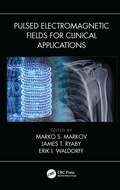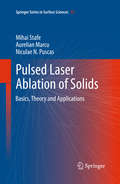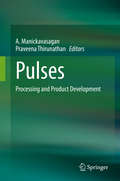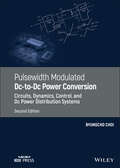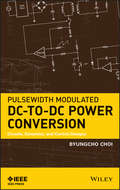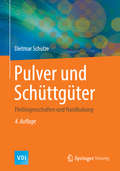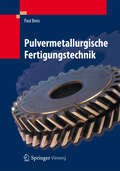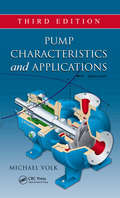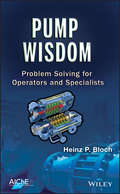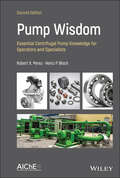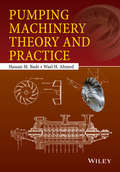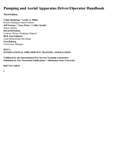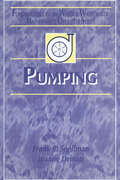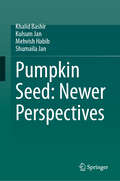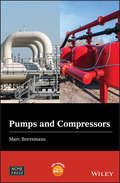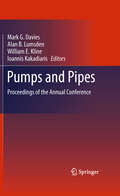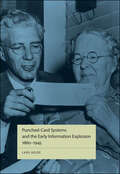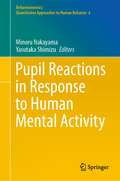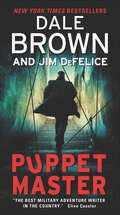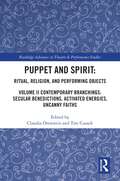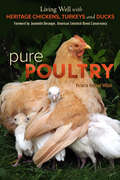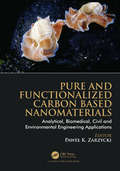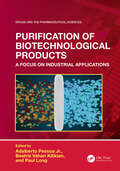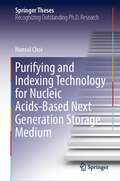- Table View
- List View
Pulsed Electromagnetic Fields for Clinical Applications
by Marko S. Markov James T. Ryaby Erik I. WaldorffPulsed Electromagnetic Fields for Clinical Applications presents the historical development, the state of art, and the future of the application of pulsed electromagnetic fields (PEMFs) for the treatment of various medical problems, including initiating various healing processes from delayed fractures and pain relief to multiple sclerosis and Parkinson’s disease. The emphasis is on the development of scientific methods to be implemented in clinical application. In perspective, this modality provides a practical, exogenous method for inducing cell and tissue modification attempted to the injured tissues to their normal physiological status. The book reviews the current state of equipment for PEMFs and highlights worldwide therapeutic achievements. It explores the past, present, and future of PEMF therapies. It presents the development of theory and laboratory research during the last 70 years. It reviews the available equipment for PEMF. It reviews the state of the art of worldwide therapeutic achievements. It includes recent achievements and applications of electroporation modalities.
Pulsed Laser Ablation of Solids
by Mihai Stafe Aurelian Marcu Niculae N. PuscasThe book introduces 'the state of the art' of pulsed laser ablation and its applications. It is based on recent theoretical and experimental studies. The book reaches from the basics to advanced topics of pulsed laser ablation. Theoretical and experimental fundamental phenomena involved in pulsed laser ablation are discussed with respect to material properties, laser wavelength, fluence and intensity regime of the light absorbed linearly or non-linearly in the target material. The energy absorbed by the electrons leads to atom/molecule excitation, ionization and/or direct chemical bond breaking and is also transferred to the lattice leading to material heating and phase transitions. Experimental non-invasive optical methods for analyzing these phenomena in real time are described. Theoretical models for pulsed laser ablation and phase transitions induced by laser beams and laser-vapour/plasma interaction during the plume expansion above the target are also presented. Calculations of the ablation speed and dimensions of the ablated micro- and nano-structures are performed. The validity and required refinement of different models in different experimental conditions is provided. The pulsed laser deposition process which bases on collecting the ablated particles on a surface is analyzed in terms of efficiency and quality of the deposited films as a function of ambient conditions, target material, laser parameters and substrate characteristics. The interaction between the incident laser and the ablation plasma is analyzed with respect to its influence on the structures of the deposited films and its capacity to generate high harmonics and single attosecond pulses which are highly desirable in pump-probe experiments.
Pulses for Food and Nutritional Security of India: Production, Markets and Trade (India Studies in Business and Economics)
by Poornima VarmaThis book provides an in-depth analysis of India’s pulses sector in terms of production, prices, markets, and trade. Pulses play a pivotal role in a developing country like India for all categories of people due to its rich protein content (double that of wheat and three times more than that of rice). Despite being an important crop from the point of view of food, nutrition, and environmental security, the focus of food security policies in developing countries has been more on wheat and rice production. This book analyses factors influencing the supply of pulses with a greater emphasis on government interventions such as minimum support price (MSP) and National Food Security Mission (NFSM), the effectiveness of MSP and factors influencing farmers’ access to MSP, the import dependency implications through a detailed import pricing behavior of major importers of major pulses. It investigates production, market dynamics, and trade implications related to two major pulses, chickpea and pigeonpea, produced by all pulse-producing States in India. Analysis of farmer's awareness of MSP and factors influencing access to MSP are undertaken through a comprehensive household survey from the States of Maharashtra, Karnataka, and Madhya Pradesh. Finally, the book analyses import implications and import pricing behaviour for all major pulses imported by India. The book would be very useful for researchers working on the issues of agricultural production and food security, for agriculture and agri-business students, as well as for policy makers to understand the inherent dynamics in the pulses sector.
Pulses: Processing and Product Development
by A. Manickavasagan Praveena ThirunathanWorld health authorities recommend people maximize their protein intake through vegetable sources (such as pulses), and reduce protein intake from animal sources. Increasing vegetable protein intake has been shown to be positively associated with the reduction of both cardiovascular-disease-related mortality and all-cause mortality. Pulse consumption has been shown to improve satiety and metabolism of glucose and lipids, due to their high protein and fiber content, which makes their consumption ideal for preventing and managing obesity. In recent years, there has been increasing demand for pulses and pulse-based products in developed countries. Several large-scale collaborative research projects on pulse products have been initiated by government agencies. Similarly, established multinational food companies have developed pulse product units. Pulses: Processing and Product Development fulfills the need for a comprehensive book on processing and products of pulses. The book addresses a specific pulse with each chapter to meet a wide range of audiences from undergraduate students to consumers.
Pulsewidth Modulated DC-to-DC Power Conversion: Circuits, Dynamics, Control, and DC Power Distribution Systems
by Byungcho ChoiExplore a fully updated reference for professional and student engineers working with pulsewidth modulated DC-to-DC power conversion The newly revised Second Edition of Pulsewidth Modulated DC-to-DC Power Conversion: Circuits, Dynamics, and Control Designs delivers a comprehensive exploration of pulsewidth modulated DC-to-DC converters for analysis and design as standalone converters and as an interconnected system. The book begins with discussions of the circuits, dynamics, and control of standalone PWM converters before moving on to examine the dynamic analysis and system design of DC power distribution systems. The distinguished authors balance theory with the practical aspects of DC-to-DC power conversion based on classical linear system theory. They include new information on the generalization of power stage modeling, the Nyquist criterion, and universal small-signal models for PWM DC-to-DC converters. The book also includes supplemental material, like a solutions manual, lecture slides, and PSpice source codes for over 250 PSpice programs for illustrative simulations. Readers will also benefit from the inclusion of: A thorough introduction to PWM DC-to-DC power conversion, power stage components, and buck converters An exploration of DC-to-DC power converter circuits, including boost converters, three basic converters, and flyback converters Discussions of the modeling and dynamics of PWM converters, including power stage transfer functions and the dynamic performance of PWM DC-to-DC converters An examination of control schemes and converter performance, including closed-loop performance and feedback compensation Perfect for senior undergraduate students in departments of electrical engineering or electronics, Pulsewidth Modulated DC-to-DC Power Conversion will also earn a place in the libraries of graduate students and practitioners of power electronics or electrical energy conversions, as well as analog/digital circuit engineers.
Pulsewidth Modulated DC-to-DC Power Conversion: Circuits, Dynamics, and Control Designs (Ieee Press Series On Power Engineering Ser.)
by Byungcho ChoiThis is the definitive reference for anyone involved in pulsewidth modulated DC-to-DC power conversion Pulsewidth Modulated DC-to-DC Power Conversion: Circuits, Dynamics, and Control Designs provides engineers, researchers, and students in the power electronics field with comprehensive and complete guidance to understanding pulsewidth modulated (PWM) DC-to-DC power converters. Presented in three parts, the book addresses the circuitry and operation of PWM DC-to-DC converters and their dynamic characteristics, along with in-depth discussions of control design of PWM DC-to-DC converters. Topics include: Basics of DC-to-DC power conversion DC-to-DC converter circuits Dynamic modeling Power stage dynamics Closed-loop performance Voltage mode control and feedback design Current mode control and compensation design Sampling effects of current mode control Featuring fully tested problems and simulation examples as well as downloadable lecture slides and ready-to-run PSpice programs, Pulsewidth Modulated DC-to-DC Power Conversion is an ideal reference book for professional engineers as well as graduate and undergraduate students.
Pulver und Schüttgüter: Fließeigenschaften und Handhabung (VDI-Buch)
by Dietmar SchulzeErfahren Sie in diesem Buch alles über die Eigenschaften von Pulvern und Schüttgütern sowie deren Anwendung in der PraxisDas theoretische Wissen um das Verhalten von Pulvern und Schüttgütern ist im Ingenieurwesen mittlerweile weit verbreitet. Beim Blick in die Praxis – speziell bei der Schüttgutlagerung in Silos – fehlt es jedoch nach wie vor an Vertrauen in diese Methode. Das möchte Dietmar Schulze mit diesem Buch über Pulver und Schüttgüter ein für alle Mal ändern. In seinem Buch erläutert er daher die Fließeigenschaften und -fähigkeiten dieser Komponenten und zeigt, wie dieses Wissen in die Gestaltung von Anlagenteilen wie Trichtern oder Silos praktisch angewendet werden kann. Anhand von Berechnungsaufgaben mit Lösungen können Sie Ihren aktuellen Wissensstand prüfen und erweitern.Von der Theorie zur Gestaltung von SchüttgutbehälternSchulze hat sein Buch über Pulver und Schüttgüter in zwei Bereiche aufgeteilt. In drei Kapiteln erörtert er die theoretischen Grundlagen zum Umgang mit Schüttgütern im Ingenieurwesen. Hier lernen Sie alles über: • Wechselwirkungen zwischen Partikeln• Fließeigenschaften und deren Messung• Einflüsse auf das Fließverhalten (z.B. Feuchtigkeit, Zeit, Fließhilfsmittelgehalt)Nach diesem theoretischen Grundlagen-Exkurs wendet sich der Autor der Schüttguttechnik in der Praxis zu. Schulze erläutert, wie Sie die gemessenen Fließeigenschaften zur funktionsgerechten Gestaltung von Schüttgutbehältern wie Silos und Trichtern anwenden können. Zudem bekommen Sie einen Einblick in apparative Aspekte sowie das praktische Messen von Fließeigenschaften – insbesondere mit Hilfe von Schergeräten.Die vierte, ergänzte Auflage – ideal für NeueinsteigerAbschließend befasst sich dieses Buch mit der verfahrenstechnischen Siloauslegung. Hier widmet sich der Autor Aspekten wie der Silogestaltung, dem Schüttgutaustrag, der Entmischung sowie dem Phänomen von Erschütterungen und Schwingungen in Silos. Für die vierte Auflage wurden in mehreren Kapiteln Ergänzungen vorgenommen, u.a. bei der Entmischung zur Probenahme und zur Bewertung der Mischungsqualität mittels statistischer Methoden, und bei der Siloauslegung mit weiteren Berechnungsdiagrammen.
Pulvermetallurgische Fertigungstechnik
by Paul BeissUnter den Oberbegriff Pulvermetallurgie fällt eine große Vielfalt an Verfahren und Produkten, von denen die Strukturwerkstoffe in der Technik die größte Wertschöpfung und Anwendungsbreite haben. Dazu sind sehr unterschiedliche Aufbereitungs- und Formgebungsverfahren entwickelt worden, die auf den Verarbeitungseigenschaften der jeweiligen Pulver beruhen. Eine Auswahl dieser Verfahren mit größerer technischer Bedeutung wird geschildert. Für Pulver, die unter Druck Grünfestigkeit entwickeln, hat das Matrizenpressen bei Raumtemperatur oder wenig erhöhten Temperaturen für die Formgebung von Bauteilen bis etwa fünf Kilogramm Masse mit weitem Abstand die wirtschaftlich größte Bedeutung. Hierzu gibt es zahlreiche Varianten für spezielle geometrische Anforderungen, z. B. Hinterschneidungen, die ausführlicher beschrieben werden. Im gepressten Zustand ist die Grünfestigkeit der Festigkeit von Kreide vergleichbar. Für die technische Anwendung bedarf es einer metallurgischen Konsolidierung durch Sintern, die aus wirtschaftlichen Gründen in schutzgasgefüllten kontinuierlichen Öfen unter Atmosphärendruck abläuft. Die Sinterbedingungen und bei kohlenstoffhaltigen Legierungsstählen die Abkühlbedingungen bestimmen das Gefüge und zusammen mit der Dichte die Festigkeitseigenschaften. Auf diese Prozesse wird detailliert eingegangen. Den Abschluss der Darstellung bildet eine umfangreiche Übersicht über mechanische und thermophysikalische Eigenschaften von Sinterstählen, besonders auch über deren Schwingfestigkeit.
Pump Characteristics and Applications (Mechanical Engineering)
by Michael VolkProviding a wealth of information on pumps and pump systems, Pump Characteristics and Applications, Third Edition details how pump equipment is selected, sized, operated, maintained, and repaired. The book identifies the key components of pumps and pump accessories, introduces the basics of pump and system hydraulics as well as more advanced hydrau
Pump Wisdom
by Heinz P. BlochLearn all the basics about pumps in one place. Clearly written by an ace consultant, this manual for operators and specialists in the petroleum industry gives readers a concise overview of the mechanics of various pumps and reviews the specifications to be considered before a pump is purchased and installed. The straight-forward text explains pump hydraulics without need of involved mathematics and provides expert advice on installing centrifugal pumps in process plants. The book also emphasizes the mechanical aspects of pumps as it delves into misunderstandings and oversights on bearings, seals, impeller trimming, lubricant application, lubricant types, and much more.
Pump Wisdom: Essential Centrifugal Pump Knowledge for Operators and Specialists
by Heinz P. Bloch Robert X. PerezExplore key facets of centrifugal pump ownership, installation, operation, and troubleshooting The Second Edition of Pump Wisdom: Essential Centrifugal Pump Knowledge for Operators and Specialists delivers a concise explanation of how pumps function, the design specifications that must be considered before purchasing a pump, and current best practices in lubrication and mechanical seals. Readers will encounter new startup and surveillance tips for pump operators, as well as additional repair and replace considerations for maintenance decision makers, new condition monitoring guidance for centrifugal pumps, and expanded coverage of operator best practices. This latest edition of Pump Wisdom includes expanded coverage of areas critical to achieving best-in-class pump reliability, including commonly encountered issues and easy-to-follow instructions for getting centrifugal pumps to operate safely and reliably. This book also provides: Comprehensible and accessible explanations of pump hydraulics Simple explorations of the mechanical aspects of pumps with coverage of bearings, seals, impeller trimming, lubricant application, and more Safety tips and instructions for centrifugal pumps Perfect for chemical, petroleum, and mechanical engineers, Pump Wisdom: Essential Centrifugal Pump Knowledge for Operators and Specialists is also an ideal resource for operators, managers, purchasing agents, machinists, reliability technicians, and maintenance workers in water and wastewater plants.
Pumping Machinery Theory and Practice
by Wael H. Ahmed Hassan M. BadrPumping Machinery Theory and Practice comprehensively covers the theoretical foundation and applications of pumping machinery. Key features:Covers characteristics of centrifugal pumps, axial flow pumps and displacement pumpsConsiders pumping machinery performance and operational-type problemsCovers advanced topics in pumping machinery including multiphase flow principles, and two and three-phase flow pumping systemsCovers different methods of flow rate control and relevance to machine efficiency and energy consumptionCovers different methods of flow rate control and relevance to machine efficiency and energy consumption
Pumping and Aerial Apparatus Driver/Operator Handbook
by Cynthia Brakhage Leslie A. Miller David DeStefano Jeff Fortney Tony Peters Libby Snyder International Fire Service Training Association StaffThe new editions of these bestselling IFSTA fire apparatus driver/operator training materials mark a new approach to training driver/operators. Previously, IFSTA published two separate manuals with student and instructor support materials: Pumping Apparatus Driver/Operator Handbook and Aerial Apparatus Driver/Operator Handbook. Fire departments with both types of apparatus needed two manuals, two curriculum and driver/operator trainees needed two exam preps to study for tests. The release of the 3rd edition of these manuals streamlines the IFSTA training resources.
Pumping: Fundamentals for the Water and Wastewater Maintenance Operator (Fundamentals for the Water and Wastewater Main Operator Series)
by Frank R. Spellman Joanne DrinanThis is the only book series devoted to explaining the full range of specialized areas required of water and wastewater plant operators. Each volume is designed to give operators the basic knowledge of a subject needed for certification, licensure, and improved job performance. Checkpoints, self-tests and a final examination with questions based on
Pumpkin Seed: Newer Perspectives
by Khalid Bashir Kulsum Jan Mehvish Habib Shumaila JanIncreased consumer awareness of the health benefits of foods has led food manufacturers to increasingly focus on the functional ingredients. The functional components found in pumpkin enhance immunity and provide a litany of health benefits for the consumer. Pumpkin is high in proteins, beneficial seed oils and antioxidant properties. Many different types of foods can be developed from pumpkin seed as well. To date there has been no reference work that documents the up-to-date knowledge regarding pumpkin seed its production, structure, health benefits and utilization to develop food products, plus the health benefits, bioavailability and accessibility. Pumpkin Seed: Newer Perspectives addresses the most recent advances and future prospects in pumpkin seed chemistry and valorization of pumpkin byproducts. The text provides researchers with a thorough understanding of new product development, use of protein in food supplementation, packaging films and many other uses. Different extraction techniques, phytochemical composition and applications in food and nutraceuticals are studied in full. Chapters deliver up-to-date information regarding the trends for the development of functional foods through pumpkin byproducts utilizing novel methods and updated technology, serving as a multidisciplinary source for researchers in food science and technology and biotechnology.
Pumps and Compressors (Wiley-ASME Press Series)
by Marc BorremansA practical guide to the majority of pumps and compressors used in engineering applications Pumps and compressors are ubiquitous in industry, used in manufacturing, processing and chemical plant, HVAC installations, aerospace propulsion systems, medical applications, and everywhere else where there is a need to pump liquids, or circulate or compress gasses. This well-illustrated handbook covers the basic function, performance, and applications for the most widely used pump and compressor types available on the market today. It explains how each device operates and includes the governing mathematics needed to calculate device performance such as flow rates and compression. Additionally, real-world issues such as cavitation, and priming are covered. Pumps & Compressors is divided into two sections, each of which offers a notation of variables and an introduction. The Pumps section covers piston pumps, radial turbopumps, axial turbopumps, rotating pumps, hydraulic pumps, and pumps with driving flow. The Compressors section covers piston compressors, rotating compressors, turbo compressors, ejectors, vacuum pumps, and compressors for cooling purposes. A virtual encyclopedia of all pumps and compressors that describes the mechanics of all devices and the theory, mathematics, and formulas governing their function Allows the reader to develop the skills needed to confidently select the appropriate pump or compressor type and specification for their applications Pumps & Compressors is an excellent text for courses on pumps and compressors, as well as a valuable reference for professional engineers and laymen seeking knowledge on the topic.
Pumps and Pipes
by Alan B. Lumsden Ioannis Kakadiaris Mark G. Davies William E. KlineThe Pumps and Pipes collaboration and conference brings together energy, medicine, and higher education in a unique shared effort, exploring ideas and research common to these important fields and stimulating discussion and sharing technologies that can further the reach and goals of each individual area. The Proceedings explores the common attributes of oil and gas technology, computational sciences and cardiovascular medicine and probe the areas where there is room to cross-fertilize and develop research and commercial programs.
Punched-Card Systems and the Early Information Explosion, 1880–1945 (Studies in Industry and Society)
by Lars HeideAt a time when Internet use is closely tracked and social networking sites supply data for targeted advertising, Lars Heide presents the first academic study of the invention that fueled today’s information revolution: the punched card. Early punched cards helped to process the United States census in 1890. They soon proved useful in calculating invoices and issuing pay slips. As demand for more sophisticated systems and reading machines increased in both the United States and Europe, punched cards served ever-larger data-processing purposes. Insurance companies, public utilities, businesses, and governments all used them to keep detailed records of their customers, competitors, employees, citizens, and enemies. The United States used punched-card registers in the late 1930s to pay roughly 21 million Americans their Social Security pensions, Vichy France used similar technologies in an attempt to mobilize an army against the occupying German forces, and the Germans in 1941 developed several punched-card registers to make the war effort—and surveillance of minorities—more effective. Heide’s analysis of these three major punched-card systems, as well as the impact of the invention on Great Britain, illustrates how different cultures collected personal and financial data and how they adapted to new technologies.This comparative study will interest students and scholars from a wide range of disciplines, including the history of technology, computer science, business history, and management and organizational studies.
Pupil Reactions in Response to Human Mental Activity (Behaviormetrics: Quantitative Approaches to Human Behavior #6)
by Minoru Nakayama Yasutaka ShimizuThis book focuses on a development for assessing mental changes using eye pupil reactions, namely extracting emotional change from the response to evaluate the viewer's interest in visual information. The pupil of the eye reacts to both brightness and emotional state, including interest, enjoyment, and mental workload. Because pupillary change is a biological signal, various artifacts influence measurements of eye images. Technical procedures are required to extract mental activities from pupillary changes, and they are summarized here step by step, although some procedures contain earlier techniques such as analog video processing. This study examines the possibility of estimating the viewer's interest and enjoyment of viewing movies by measuring the dynamic pupillary changes, blinking, and subjective interest responses. In evaluation of pupil size, there was a significant difference in pupil size between the higher and the lower shot for the degree of subject interest response in each kind of movies. The first part of the book shows a pupil reaction model for brightness changes to extract mental activities. Pupil reactions were observed for various visual stimuli in brightness changes. With regard to the characteristics of pupillary changes, a model with a three-layer neural network was developed and the performance was evaluated. Characteristics of pupil reactions during model development are summarized here. The second part examines the possibility of estimating the viewer's interest and enjoyment of television programs by measuring dynamic pupillary changes, blinking, and subjective interest responses. The final part describes a development of estimation model of pupil size for blink artifact. The model development was able to estimate pupillary changes and pupil size while the viewer was blinking and was applied to pupillary changes in viewing television programs.
Puppet Master (Puppetmaster #1)
by Dale Brown Jim DeFeliceNew York Times–Bestselling Authors: A roboticist aids the FBI in fighting Eastern European criminals using AI—until things go very wrong . . . Louis Massina is revolutionizing the field of robotics. His technological wonders are capable of locating disaster survivors, preventing nuclear meltdowns, and replacing missing limbs. After one of Massina’s creations makes a miraculous rescue, an FBI agent recruits him to pursue Russian mobsters running a massive financial scam—and not coincidentally, suspected of killing the agent’s brother. Massina agrees to deploy a surveillance bot that uses artificial intelligence to follow its target. But when he’s thrust into a dangerous conspiracy, the billionaire inventor decides to take matters into his own hands—unleashing the greatest cyberweapons in the world and becoming the Puppet Master . . . .Acclaim for Dale Brown“Authentic [and] riveting.” —San Francisco Chronicle“Gripping.” —New York Times
Puppet and Spirit: Volume II Contemporary Branchings: Secular Benedictions, Activated Energies, Uncanny Faiths (ISSN)
by Claudia Orenstein Tim CusackThis anthology of essays, a companion to Puppet and Spirit: Ritual, Religion, and Performing Objects, Volume I, aims to explore the many types of relationships that exist between puppets, broadly speaking, and the immaterial world.The allure of the puppet goes beyond its material presence as, historically and throughout the globe, many uses of puppets and related objects have expressed and capitalized on their posited connections to other realms or ability to serve as vessels or conduits for immaterial presence. The flip side of the puppet’s troubling uncanniness is precisely the possibilities it represents for connecting to discarnate realities. Where do we see such connections in contemporary artistic work in various mediums? How do puppets open avenues for discussion in a world that seems to be increasingly polarized around religious values? How do we describe, analyze, and theorize the present moment? What new questions do puppets address for our times, and how does the puppet’s continued entanglement with these concerns trouble or comfort us? The essays in this book, from scholars and practitioners, provide a range of useful models and critical vocabularies for addressing this aspect of puppet performance, further expanding the growing understanding and appreciation of puppetry generally.This book, along with its companion volume, offers, for the first time, robust coverage of this subject from a diversity of voices, examples, and perspectives.
Pure Poultry
by Victoria Redhed MillerPure Poultry is a timely resource for new and experienced poultry keepers who want to raise heritage breeds as an integral part of a more sustainable food system. This inspiring "how-to and why-to" guide combines revealing and often humorous anecdotes with detailed information on everything from housing, breeding and day-to-day care, to cooking and food preservation.
Pure and Functionalized Carbon Based Nanomaterials: Analytical, Biomedical, Civil and Environmental Engineering Applications
by Paweł K. ZarzyckiThis book describes in a comprehensive manner latest studies conducted by various research groups worldwide focusing on carbon and related nanomaterials. Fourteen chapters of this book deal with a number of key research topics and applications of pure and functionalized carbon nanomaterials and their hybrid nanocomposites. Specifically, the authors have presented interdisciplinary investigations including: (i) carbon nanoparticles and layers synthesis, (ii) analytical aspects of carbon nanomaterials and their characterisation under different conditions as well as (iii) various applications of carbon nanoparticles. They have reported and summarised key applications of carbon particles or nanoobjects in pharmacy, biomedicine, agriculture and food industry, water treatment, physicochemical analysis, optoelectronics, electronic and magnetic materials for supercapacitors or radar adsorbing materials, tribology, chromatography, electrophoresis, bioanalysis, nanobiocatalysis, biofuels production as well as environmental remediation.
Purification of Biotechnological Products: A Focus on Industrial Applications (ISSN)
by Paul Long Pessoa Jr. Adalberto Beatriz Vahan KilikianThis outstanding text focuses on providing professionals and students working in the pharmaceutical and biotechnology field with the background necessary for developing of a product or process and with the necessary rigor required by federal regulatory agencies in the pharmaceutical industry. The material will enable teachers, lecturers and professors in biotechnology to prepare courses on basic concepts and applications for the purification of biotechnological products of industrial interest. These can be applied in practice, for example, with projects on purification development on an industrial scale or useful unit operations for the development of bioproducts of commercial interest.Features: Purification and development of new bioproducts and improvement of those being produced. Provides a background and concepts on the purification of biomolecules and with an industrial perspective. It allows professionals to understand the entire process of developing a biopharmaceutical or bio-food, from bench to industry in biotechnology; one of the fastest-growing sectors of the economy. It promotes the dissemination of information in a didactic way which is of paramount importance for interdisciplinary fields It enables the reader to follow step-by-step stages of the development of a new biopharmaceutical, and allows the optimization of existing processes.
Purifying and Indexing Technology for Nucleic Acids-Based Next Generation Storage Medium (Springer Theses)
by Hansol ChoiThis book introduces novel purification technology for the complex oligonucleotide libraries. Since the concept of synthesizing oligonucleotides (oligos) has been proposed, research fields such as nucleic acid-based therapies (CRISPR-Cas9, DNA/RNA vaccines, RNAi), synthetic biology, protein engineering, and DNA-based data storage have bloomed. The COVID-19 pandemic underscores the potential of nucleic acid-based technologies, such as vaccines or diagnostics. As they emerge as the most promising weapons against the current pandemic, increasing need for highly accessible nucleic acid purification technologies is expected. To meet this demand, an oligo purification technology that can be applied to complex oligo libraries and can purify oligos with single-base resolution is developed. In addition, the purification technology can be applied to highly complex oligo libraries of different lengths, enabling the simultaneous purification of complex oligo libraries with different lengths. The proposed technology can be easily accessed by users and would help accelerate numerous research fields that utilize oligos as fundamental building blocks.
